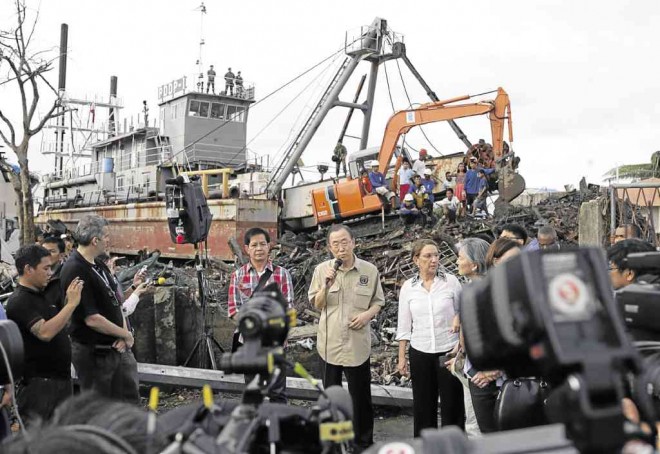In Tacloban, dredger ugly storm reminder
TACLOBAN CITY—Its light gray paint peeling off as rust spreads in patches, the dredge barge still slumps on soft ground, surrounded by growing grasses, near a cluster of houses in Barangay (village) 75 in Tacloban City. A portion smacks the gate of an abandoned dwelling.
“We want it removed,” said Ester Daa, the barangay chair. “Aside from the fact that it blocks our passage, it has become a daily reminder to us of what happened during Yolanda’s wrath.”
The 500-meter-long barge owned by the Department of Public Works and Highways (DPWH) was beached right at the passageway of the village along the Cancabato Bay, over 200 meters from the main road. It is one of 10 vessels swept inland by storm surges generated by Supertyphoon “Yolanda” (international name: Haiyan).

Ki-moon (center) talks to reporters in Tacloban City about a month after Supertyphoon “Yolanda” struck the Visayas. In the background is a dredge barge of the Department of Public Works and Highways that is still in the site. AP
Nine had been removed, including the biggest—the MV Eva Jocelyn—in Anibong District.
Cesar Dabe, 50, a resident of Barangay 75, said he hoped the DPWH barge would finally be dismantled.
“It has been more than a year since it was washed ashore. We cannot afford to see it forever as it will only remind us about the supertyphoon,” he said.
Article continues after this advertisementAfter storm surges swamped the village, Dabe and his family climbed onto the barge to seek temporary shelter, along with 37 other families who lost their homes.
Article continues after this advertisement“We were actually the last one to leave the ship,” he said. He said he and his family left on Dec. 20 last year to put up a tent elsewhere.
For what it’s worth now, the vessel served as backdrop when United Nations Secretary General Ban Ki-moon visited Tacloban on Dec. 16, 2013, and announced his appeal to the world for help for Yolanda victims.
Residents of Barangay 75 have been asking the DPWH to pull out the barge, but the agency has not acted on their request more than a year after the monster storm.
Sought by the Inquirer for comment, Romy Gumban, chief of the DPWH’s equipment and management division, said he needed to seek clearance from his superiors first before giving any statement. He, however, said he was sure the vessel would eventually be removed.
Lt. Paul Gonzales, Philippine Coast Guard-Tacloban station commander, said Coast Guard men had been awaiting official word from the DPWH on what to do with the dredger.
“We cannot remove the ship by ourselves. It is government owned and we will just wait for the DPWH to seek permit to remove it,” Gonzales said.
In Anibong, only the bow of the 3,000-ton Eva Jocelyn remains. The city government plans to retain it in a memorial park to be put up in the area, but some residents also prefer its removal as it continues to remind them of the tragedy that befell their community.
“While we cannot do anything about it as it is the desire of the city government, we feel it should be completely removed,” said Crisanto Gabrieles, 29.
Gabrieles’ mother, Alice, 70, was among the 26 killed when the ship, which was then carrying cement bags, slammed into their houses. Eleven were pinned down, according to Ma. Rosario Bactol, chair of Barangay 86 which covers Anibong.
While the ship has become a symbol of the tragedy, it also helped bring tourists, including foreigners, to the village. Bactol said that during Pope Francis’ visit to Tacloban on Jan. 18, tourists came to take selfies with the Eva Jocelyn as background.